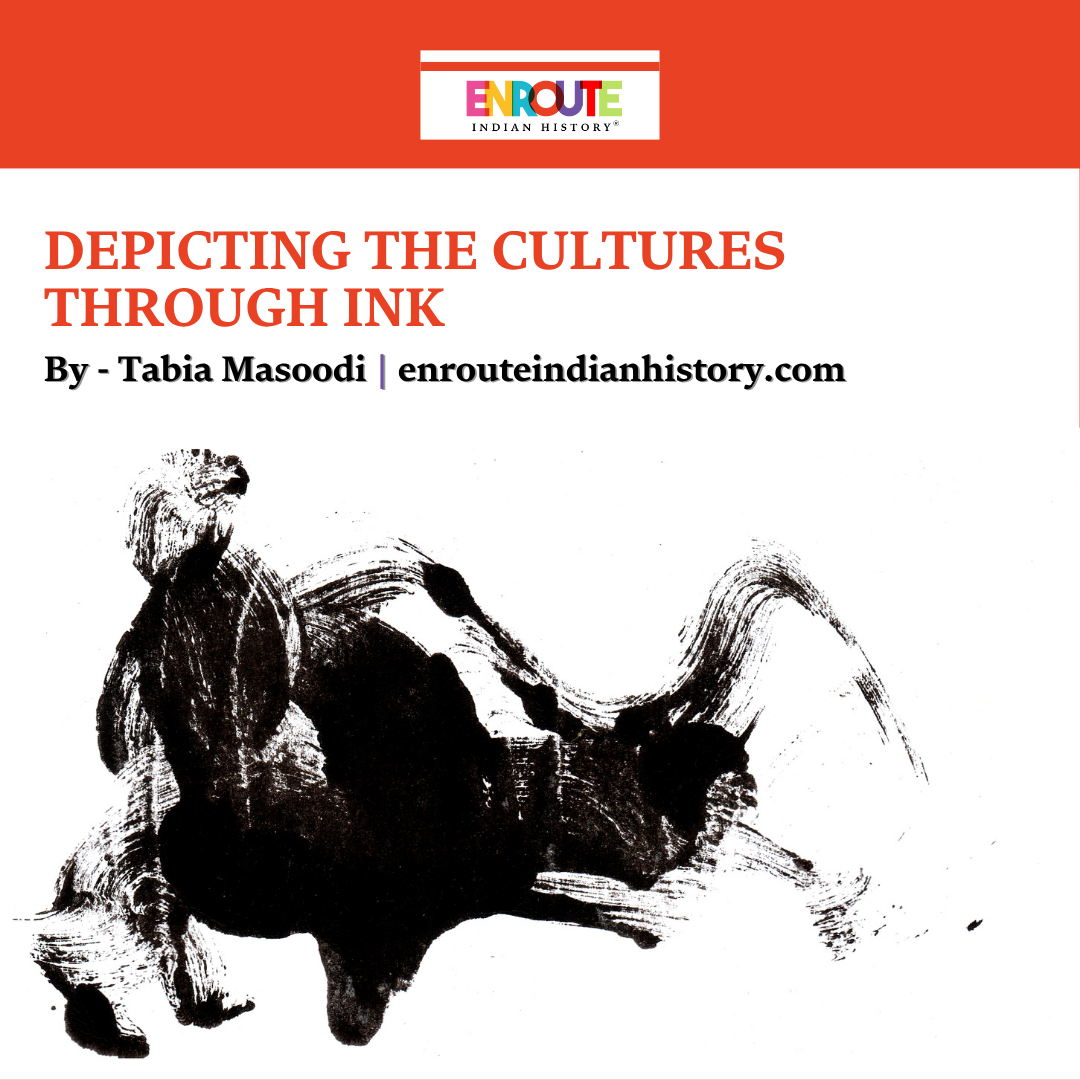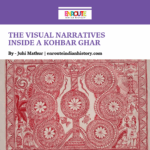
By Tabia Masoodi
Tattoos are not just decorative art but a universal visual language that narrates the tale of beauty, identity, resilience, and resistance, each motif serving as an archive of societal emotions. They are a story that comes alive on the canvas of skin, an intimate art form forever etched to its storyteller. These tattoos are lines paying tribute to legacies, with each curve being a silent song of individuality. These captivating designs bloom throughout the body like sacred vines among indigenous groups.
In India, especially among tribal communities, tattooing is deeply rooted in the socio-cultural fabric and religious life of these groups (Ghosh, 2020). Tattooing serves as a marker of many aspects of life, conveying these communities' social, cultural, and political conditions, as well a their spirituality and important milestones. It signifies kinship, tribal affiliations, rites of passage and social rank. Tattoos reflect resilience and the act of reclaiming one's identity agency.
HISTORY OF TATTOOS
For centuries, Indian tribal tattoos have been an amazing representation of the persistent nature of their indigenous cultures. The evidence from historical literature and archaeological findings traces the origins of tattoos to prehistoric societies. India's tattooing heritage stretches back
thousands of years, across various regions and cultures, with the earliest evidence of tattooing dating back to the Mesolithic period, with rock paintings at sites like Bhimbetka in Madhya Pradesh depicting human figures adorned with body art. However, the exact origin is in conflict.
Some evidence suggests its origin dates back to the Harappan civilisation. However, due to a lack of skin preservation methods, the research is not conclusive. The prehistoric practice of tattooing is called Gudna, which translates to burying the needle bodies and using thorns, soot, and animal fat to create the tattoos. The ancient, maze-like design was later replicated by tribal communities as body art, each region having their distinct identity, customs and symbolism(Ghosh, 2023).
ORIGIN IN MYTHOLOGY, CULTURAL SIGNIFICANCE AND PRACTICAL IMPLEMENTATION:
The history of tattooing among Indian tribes is explained by several tales and oral traditions. According to a widely circulated myth among the Gond and Kharia tribes, tattooing originated as a means of protection and identity. In one tale, Parvati, the consort of Lord Shiva, became enraged over an instance of tribal women misidentifying themselves and ordered that they get tattoos to help them stand out from the crowd. This myth emphasises how important tattoos are for defining one's individuality and avoiding confusion, particularly in social situations. In another popular legend from central India, during ancient times, God assigned roles to people: the Brahmins received a pen, the Gonds a plough, and the Kewats water. The Ojha was given a dhol and became a musician. Finding his work unprofitable, he grew frustrated and one day returned home with nothing, taking out his anger on his wife. Deeply distressed, she stopped eating and drinking. Moved by her suffering, God appeared, drew black dots on her face using
fluid from the Sarei tree, and told her to take up tattooing as a profession. Since then, tattooing has become an important cultural and spiritual art among the tribes of central India, symbolising identity, beauty, and resilience.
Another tradition among the Kharia tribe recounts that tattooing began as a memorial to a historical event. During a migration, Kharia women defended their group from enemy abduction, and in memory of their bravery, they began marking their foreheads with tattoos resembling flags. This highlights how tattoos served not just as adornment but as living records of collective memory and resilience.
Tattoos are rooted in spiritual and cultural beliefs and are considered to ward off evil spirits and accompany the wearer into the afterlife. Tattoos mark important life stages, such as puberty, marriage readiness, or spiritual initiation. Among tribal communities like the Baiga, godna tattoos prepare women for childbirth and safe passage into the afterlife, symbolising protection and cultural identity. Tattooing among ascetics often involves rituals, prayers, and meditation, making the process itself a spiritual act. The pain endured is seen as a form of penance or purification.
Beyond myth, the tradition was also influenced by pragmatic considerations. In many areas, tattoos were used to disfigure women to make them unattractive, to shield them from being sexually exploited by outsiders or kidnapped by enemy tribes. Tattoos became a visible statement of perseverance and a kind of social defence. In the Dhanus of Bihar, for instance, lower-caste women's faces and bodies were inked to deter predatory upper-caste men from sexually harassing women. Some tribes in the northeast saw bare skin as shameful or lacking, and nose plugs and face tattoos were both distinctive symbols of identity and beauty and a deterrent to kidnapping. Tattooing is not only a way of identification but also a way to reclaim one's identity and agency. The Ramnami community in Chhattisgarh is a movement started by the untouchables who are disallowed by the Brahmins to enter the temples. The use of tattooing as a medium to reclaim their religious agency and a means of protection from the physical abuse by Brahmins, by tattooing the name of Ram in Sanskrit on all of their bodies.
TATTOOS AND TRIBAL WOMEN:
Baiga Tribe: A semi-nomadic tribal community, the Baiga, settled in the forests of Madhya Pradesh and Chhattisgarh, is known for its unique tradition of tattoos called Godna. The women of this tribe believe that tattooing is an essential part of their identity and cultural heritage. The tribal community inculcates the practice of tattooing from childhood, with the first tattoo being engraved at around the age of 8 to 10. The tattoo is typically engraved on the forehead, and if it is not present, the girl is not considered a true Baiga. Their engraving of tattoos does not stop; as females of the tribe grow, more tattoos are added to different body parts as a rite of passage. These tattoos mark significant life events like marriage or childbirth. The final tattoo, called Chhati Godai, is engraved after a woman delivers her first child. The tattoos also serve as a visual language, helping to identify individuals and promoting social cohesion and cultural preservation.
Fire, crops, peacocks, and chariots are among the symbolic elements found in godna designs, which are said to bring good fortune and provide spiritual protection. The tattoos are placed painfully and ceremonially, frequently in forest settings, utilising natural inks and traditional instruments. In the past, tattoos were considered to be permanent decorations, to be a part of the soul after death, and to offer protection from disease and the elements. For example, images of goddess Chandi on the forehead protect the hair parting. Tattoos are also seen as strengthening women's bodies and souls (Goswami, 2019).
Ao Naga: Ao Naga is yet another notable ethnic group that is native to the Mokokchung District in Nagaland, Northeast India, territories from Tsula (Dikhu) in the east to Tsurang (Disai) in the west. The origin narrative of the Ao, which is essential to their oral tradition and sense of self, is the legendary emergence from six stones in Lungterok. They call themselves "Aoer," which means "those who came." Tattooing was a standard of beauty and a necessary puberty ritual for Ao Naga women; females typically got tattoos in their early teens, and those without tattoos were viewed as unfit for marriage. The tattoos represented a girl's adulthood, initiation, and full social incorporation. Post-harvest was the season of gendered, ritualistic tattooing, and this severely banned men from being tattooed. It was believed to enhance social unity and facilitate healing. The village council selected tattoo designs that varied from one village to another, often reflecting traditional clothing and clan affiliation. Matrilineally inherited tattooists among women performed the ritual procedure, which involved five tattooing sessions followed by rest.
Ao Naga tattoos conveyed not just aesthetics; they conveyed good health, fertility, as well as standing in the society, and they distinguished slaves from free women, cementing group relationships. Although the tradition declined due to modernisation as well as the influence of Christianity, the tattoos of the Ao Naga people are a vigorous symbol of cultural pride as well as identification.
Toda (Tamil Nadu's Nilgiri tribe): The Toda women of Tamil Nadu's Nilgiri Hills are renowned for their distinctive tattoo traditions. Toda tattoos, also known as pachakutharathu in the local language, are made using a traditional hand-poking technique with cane thorn-tipped needles dipped in soot from burnt napthi tree bark to create deep blue geometric patterns on the skin. Such tattoos, which extend to the hands, calves, shins, and occasionally to the face, are motivated by the same elements of Toda embroidery- ridges, points, and kollam motif, said to trap evil demons and safeguard the wearer until a reunion with their kin. Such tattoos, which extend to the hands, calves, shins, and occasionally to the face, are motivated by the same elements of Toda embroidery- ridges, points, and kollam motif, said to trap evil demons and safeguard the wearer until a reunion with their kin.
Being a ritual of passage indicating maturity, identity, and shielding from evil spirits, tattooing is a rite of passage in Toda women. As a means to preserve the ritual's spiritual ambience, the menfolk cannot be a part of this customary ritual, and it is an exclusively feminine ritual. Tattoos, in earlier times, solidified relationships between members of society and distinguished the Todas from neighbouring societies. Modernisation and lifestyles have caused the tradition to wane, but Toda tattoos are still a strong connection to tradition, and the tribe's renowned shawl work now features their designs.
Kutia Kandha: The Odisha tribe Kutia Kandha is quite known for its noticeable facial tattoo culture, particularly among females. Locally, these tattoos are known as 'Kuyaghat', and they are believed to have deep tribal identity and spirituality. As a rite of passage into maturity, girls are
traditionally given geometric face tattoos during specific community ceremonies, which sets them apart from other tribes and signifies their social transformation. To assist the girls bear the pain, the community gathers and sings traditional songs while elders apply natural inks made from soot and plant extracts and thorns or metal needles.
The tattoos act as permanent identification and are not just ornamental. According to the Kutia Kondh, these scars strengthen a sense of affiliation that goes beyond this life by ensuring that people can identify with one another in the realm of spirits after death. Clan, social standing, and spiritual beliefs are all symbolised by the lines, dots, and curves that make up each pattern. The tattoos are proudly worn as markers of resiliency and cultural heritage, and the agony and endurance needed are viewed as necessary preparation for life's challenges. Despite the practice's decrease due to modernisation, Kutia Kandha women's facial tattoos are nevertheless a potent symbol of their enduring identity and customs. There are hundreds of tribes in India, and all of them have a tradition of tattooing with similar stories to share. However, a change in societal attitude coupled with a multitude of other causes has led to its decline.
DECLINE OF TATTOO CULTURE WITHIN INDIAN TRIBES:
In Indian indigenous tribes, traditional tattooing was once very popular, but several causes have contributed to its eventual demise. The exposure to a global world and modernisation has led to a change in the perception of how people used to see traditional tattooing, once the reason for pride and identity, is now seen as something inferior to modern beauty trends and standards. The colonial effect is written all over it, which reiterates that indigeneity is primitive, grotesque and savage, and all those colonised internalised it. The creation of the global village has also led to cultural syncretism and acculturation, diluting the distinctiveness of tribal tattoo traditions. The knowledge about health implications and unhygienic practices has led to its decline. This has led to a decline in demand that has, in turn, resulted in a decline in traditional tattoo artists, with many of them abandoning their craft.
AN INSPIRING EXAMPLE IN THE MĀORI TRIBE
There is an inspiring tribe in a distant place, the Maori population of New Zealand, whose women proudly display their Ta moko, a traditional Maori tattoo art, while the cultural significance and pride of Indian traditional tattooing loses its appeal. Traditional Maori tattoos are a potent way to convey one's cultural identity, heritage, and social standing. Moko Kauae, a tattoo on the chin and occasionally the lips that has a design unique to the owner, is a prominent form for Maori women. These express an inner identity that already exists within the person and include personal narratives and tribal symbols. The moko kauae, which was traditionally wornn only by women of great status or accomplishment, is now widely seen as the inheritance of all Māori women, signifying resiliency and the restoration of cultural pride following the turmoil of colonisation Today, Māori women continue to receive moko kauae as a statement of cultural pride and to honour their lineage.
References
Ghosh, Payel. "Tattoo: A Cultural Heritage." Antrocom Journal of Anthropology, vol. 16, no. NA, 2020, pp. 295-304. antrocom.net, https://www.antrocom.net/wp/wp-content/uploads/2024/05/ghosh-tattoo-cultural-heritage.pdf.
Goswami, Manash Pratim. "Tattoo Culture of the Baiga Women (A study of the significance of tattoo culture of the Baiga tribal women of Madhya Pradesh)." SROTASWINI: A PEER- REVIEWED JOURNAL OF THE J.B. COLLEGE WOMEN'S CELL, vol. 4, no. NA, 2019, pp.
136-145, https://srotaswini.in/images/downloads/vol_4/Srotoswini__Vol._IV__2019.pdf.
H., Sara. "The Caste-Marking Tattoos Of India." homegrown.co.in, 2021,
https://homegrown.co.in/homegrown-voices/the-caste-marking-tattoos-of-india-what-they-signified-for-different-tribes. Accessed 26 April 2025.
Nathania, Renata. "The Toda Tribe Of The Nilgiris: A Tradition Of Tattoos To Embroidery." Newsgram, 15 August 2021, https://www.newsgram.com/general/2021/08/16/the-toda-tribe-of-the-nilgiris-a-tradition-of-tattoos-to-embroidery.
Williams, Amanda. "Indian Tribal Tattoos: Exploring The Profound Meanings Behind Ancient Body Art." https://www.christianwebsite.com/, 2024, https://www.christianwebsite.com/indian-tribal-tattoos-with-meaning/. Accessed 26 April 2025.
Ghosh, Ritwik. "Indian Tattoos: A Lost Tradition." Imaging India ISBN: 978-93-94808-55-3 (2023): n. pag. Print.
Available https://www.academia.edu/122222062/Indian_Tattoos_A_Lost_Tradition Kavahru, A. and Ndang, C., The Culture of Tattooing in Woman Society: The Ao Nagas and The Konyak Nagas, [online] Available at: <https://www.ijfmr.com/papers/2023/4/4325.pdf>
[Accessed 28 Apr. 2025].


















